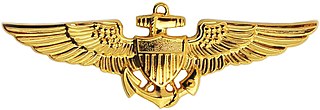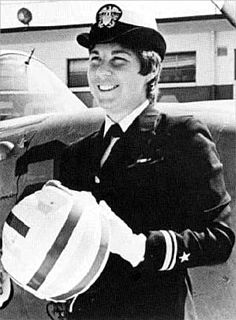
A flight surgeon is a military medical officer practicing in the clinical field of aviation medicine. Although the term "flight surgery" is considered improper by purists, it may occasionally be encountered.
An aviator badge is an insignia used in most of the world's militaries to designate those who have received training and qualification in military aviation. Also known as a Pilot's Badge, or Pilot Wings, the Aviator Badge was first conceived to recognize the training that military aviators receive, as well as provide a means to outwardly differentiate between military pilots and the “foot soldiers” of the regular ground forces.
The Observer Badge is a military badge of the United States armed forces dating from the First World War. The badge was issued to co-pilots, navigators, and flight support personnel who had received a variation in the training required for the standard Pilot's Badge. The Observer Badge survived through the Second World War and into the 1950s, at which time the concept of an Observer Badge was phased out in favor of the modern Aircrew Badge and Navigator-Observer Badges. In addition to wings for Naval Aviators and Naval Flight Officers, the United States Navy still maintains an "Observer Badge" which is issued to flight-qualified mission specialists, such as a select number of meteorologists and intelligence officers in both the U.S. Navy and U.S. Marine Corps. The U.S. Air Force awards its USAF Observer Badge, which is identical to the USAF Navigator Badge, to Air Force officers who have qualified as NASA Space Shuttle Mission Specialists, have flown an actual mission aboard the shuttle and/or the International Space Station and who are otherwise not previously aeronautically rated as an Air Force pilot or navigator.

A United States Aviator Badge refers to three types of aviation badges issued by the United States Armed Forces, those being for Air Force, Army, and Naval aviation.

John Henry Towers was a highly decorated United States Navy four-star Admiral and pioneer naval aviator. He made important contributions to the technical and organizational development of naval aviation from its beginnings, eventually serving as Chief of the Bureau of Aeronautics (1939–1942). He commanded carrier task forces during World War II, and retired in December 1947. He and Marc Mitscher were the only early Naval Aviation pioneers to survive the hazards of early flight to remain with naval aviation throughout their careers. He was the first naval aviator to achieve flag rank and was the most senior advocate for naval aviation during a time when the Navy was dominated by battleship admirals. Towers spent his last years supporting aeronautical research and advising the aviation industry.
A naval flight officer (NFO) is a commissioned officer in the United States Navy or United States Marine Corps who specializes in airborne weapons and sensor systems. NFOs are not pilots, but they may perform many "co-pilot" functions, depending on the type of aircraft. Until 1966, their duties were performed by both commissioned officer and senior enlisted naval aviation observers (NAO).

Naval Air Station Pensacola or NAS Pensacola, "The Cradle of Naval Aviation", is a United States Navy base located next to Warrington, Florida, a community southwest of the Pensacola city limits. It is best known as the initial primary training base for all U.S. Navy, Marine Corps and Coast Guard officers pursuing designation as naval aviators and naval flight officers, the advanced training base for most naval flight officers, and as the home base for the United States Navy Flight Demonstration Squadron, the precision-flying team known as the Blue Angels.

A naval aviator is a commissioned officer or warrant officer qualified as a manned aircraft pilot in the United States Navy or United States Marine Corps. While they complete the same undergraduate flight training as Navy and Marine Corps manned aircraft pilots, and are awarded the same aviation breast insignia, a United States Coast Guard manned aircraft pilot is officially designated as a "Coast Guard aviator".

Marine Fighter Attack Training Squadron 101 (VMFAT-101) is a United States Marine Corps F/A-18 Hornet training squadron. The squadron is based at Marine Corps Air Station Miramar, California and falls under the command of Marine Aircraft Group 11 (MAG-11) and the 3rd Marine Aircraft Wing.

Strike Fighter Squadron 106 (VFA-106), also known as the "Gladiators", is a United States Navy F/A-18 Hornet and F/A-18E/F Super Hornet Fleet Replacement Squadron stationed at Naval Air Station Oceana, Virginia.

U.S. Air Force aeronautical ratings are military aviation skill standards established and awarded by the United States Air Force for commissioned officers participating in "regular and frequent flight", either aerially or in space, in performance of their duties. USAF aeronautical badges, commonly referred to as "wings" from their shape and their historical legacy, are awarded by the Air Force in recognition of degrees of achievement and experience. Officers earning these badges and maintaining their requirements are classified as rated officers and receive additional pay and allowances.

Strike Fighter Squadron 125 (VFA-125), also known as the "Rough Raiders", is a United States Navy strike fighter squadron based at Naval Air Station Lemoore, California. The "Rough Raiders" are a Fleet Replacement Squadron flying the F-35C Lightning II.

Barbara Ann Allen Rainey was one of the first six female pilots in the U.S. armed forces. Rainey received her wings of gold as the first female to be designated a naval aviator in February 1974 and became the first Navy woman to qualify as a jet pilot. She attained the rank of Lieutenant Commander in the United States Navy. She was killed in an aircraft crash in 1982 while performing her duties as a flight instructor.

United States Marine Corps Aviation is the aircraft arm of the United States Marine Corps. Marine Corps aviation units have a very different mission and operation than their ground counterparts and thus have their own history, traditions, terms, and procedures. Aviation units within the Marine Corps are assigned to support the Marine Air-Ground Task Force, as the aviation combat element, by providing six functions: assault support, antiair warfare, close air support, electronic warfare, control of aircraft and missiles, and aerial reconnaissance. The Corps operates both rotary-wing and fixed-wing aircraft mainly to provide transport and close air support to its ground forces. Other aircraft types are also used in a variety of support and special-purpose roles. All Marine Corps aviation falls under the influence of the Deputy Commandant for Aviation, whose job is to advise the Commandant of the Marine Corps in all matters relating to aviation, especially acquisition of new assets, conversions of current aircraft, maintenance, operation, and command.

Richard C. Mangrum was a United States Marine Corps lieutenant general who served as Assistant Commandant of the Marine Corps from 1965 to 1967. Mangrum was a Marine Corps aviator who was awarded the Navy Cross and the Distinguished Flying Cross for his actions during the Guadalcanal Campaign in World War II.

Naval Support Activity Mid-South, in Millington, Tennessee, is a base of the United States Navy. A part of the Navy Region Southeast and the Navy Installations Command, NSA Mid-South serves as the Navy’s Human Resources Center of Excellence. The base is host to several commands and other military tenants: Navy Personnel Command, Navy Recruiting Command, the Navy Manpower Analysis Center, a Marine reserve Company - Bridge Company C and the US Army Corps of Engineers Finance Center. More than 7,500 military, civilian, and contract personnel are assigned/work on base.

A squadron in air force, army aviation, or naval aviation is a unit comprising a number of military aircraft and their aircrews, usually of the same type, typically with 12 to 24 aircraft, sometimes divided into three or four flights, depending on aircraft type and air force. Land based squadrons equipped with heavier type aircraft such as long-range bombers, cargo aircraft, or air refueling tankers have around 12 aircraft as a typical authorization, while most land-based fighter equipped units have an authorized number of 18 to 24 aircraft.
The US Navy had four programs for the training of naval aviators.

Karl Schmolsmire Day was a naval aviator of the United States Marine Corps Reserve who rose to the rank of Lieutenant General. A veteran of World War I, Day served with Northern Bombing Group on the Belgian front and received Navy Cross, the United States military's second-highest decoration awarded for valor in combat. He then resigned his commission and worked in various civilian jobs until the beginning of World War II. Day was subsequently recalled to active duty and served as Air Base Commander during the Battle of Peleliu in September 1944.

David Hugh McCulloch was an early American aviator who worked with Glenn Curtiss from 1912. Curtiss was a contemporary and competitor to the Wright brothers, Wilbur and Orville, who had made the first flights at Kitty Hawk in 1903. Curtiss won the world's first air race at Reims in France in August 1909, and was now becoming the driving force in American aviation. McCulloch's early work with Curtiss consisted of demonstrating, training and selling Curtiss planes and participating in early developments of flight. He trained the First Yale Unit, and in two consecutive days in 1917, he and several of his pupils from the First Yale Unit made flights that convinced the Navy to bring aircraft aboard ships. Later, McCulloch was co-pilot with Holden C. Richardson and flight commander John Henry Towers of the NC-3, the leader of the three Navy flying boats making the first flight across the Atlantic Ocean.



















